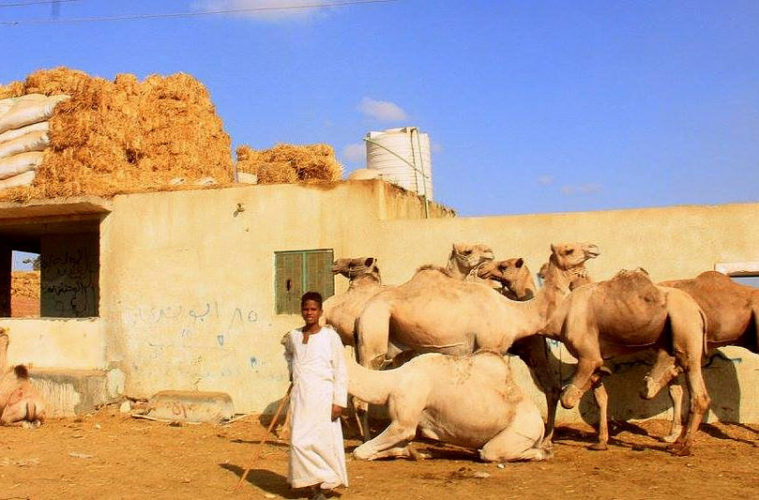Traveling and exploring new places can often be a mixed bag. It is not always roses, wine, and pretty pictures. Sometimes, you stumble upon places or face experiences that leave a bitter aftertaste. As a travel writer, I have often faced the dilemma of presenting the negative aspect of an experience, but then if you are honest, occasionally you do write about not so nice things of places you really love. The Birqash Camel Market near Cairo was one such experience and I came back from it feeling very traumatized.
Table of Contents
Birqash Camel Market was a harsh, photogenic culture shock
My father-in-law had warned me against visiting Birqash Camel Market, but being a curious cat, that I am, I refused to listen to him. So one morning, at my insistence, he drove me and Tarek to Birqash Camel Market and it took me about 30 minutes t0 flee from there. To say, that it resembled a cruel, primitive place would be a strange exaggeration and understatement at the same time. Birqash Camel Market has existed for centuries and for that part of the world, Northern Africa it is a timeless institution. However, that does not negate the cruel treatment inflicted upon the camels by some traders and the experience is a harsh, photogenic culture shock.
You may also like: The flower market of Bangkok

The 40 Day Road through Sub Saharan Africa leads to Birqash Camel Market
The Birqash camel market is one of the biggest markets for camel meat in Africa and it is located on the desert plain, about 60 kilometers away from Cairo. Every day hundreds of camels are herded along the famous Darb al-Arba’in or the ‘40 Days Road’. This is an ancient caravan route that starts in Omdurman near Khartoum in Sudan and ends in Birqash. In ancient times the famous Arab historian, Ibn Khaldun, reported that around 12,000 camel caravans traveled along the Darb al-Arba’in to the market which used to be located near the Al-Azhar mosque in Islamic Cairo. With time, as the city grew, its booming population pushed the camel market out of the urban boundaries into the deserted plain of Birqash.
Recommended Read: Markets and more of Phnom Penh
This is not for the faint-hearted
This has extended the route and the camels travel on the backs of large trucks through Sudan, Eritrea, Somalia, and southern Egypt to reach Birqash. By the time these poor animals arrive at their destination, many camels are ill or emaciated due to traveling over 700 miles in poor conditions. But their troubles don’t there, as the healthy and wounded camels are made to hobble by their owners to prevent them from running away. This does not stop the animals from attempting to flee, though very few manage to get very far. The truant camels are quickly rounded up and beaten violently back into submission by their angry owners. The traders of Birqash Camel Market are no-nonsense, hard-nosed business of various nationalities who spend considerable amounts of their lives on the road. They are also superb negotiators and watching them bargain a sale is one of the highlights of this market.
Suggested Read: The flower market of Da Lat in Vietnam

How to get to the Birqash Camel Market?
You can hire a taxi to Birqash Camel Market from Cairo or rent a car for half a day.
When to go?
The market lasts from dawn until mid-afternoon every Friday and it is busiest between 6 am and 8.30am.
Tips for visiting Birqash Camel Market
The market is a heavily male-dominated area and women will receive less unwanted attention by dressing conservatively. Watch out for the pickpockets in the busier sections. The traders are accustomed to tourists and are generally happy to have their photos taken. Make sure to ask beforehand and always be alert to bolting camels. Wear protective shoes as you might have to run from a camel. You also don’t want to step on the numerous camel droppings. Talk to different camel owners to learn about their diverse backgrounds. Many of them come from the Sub-Saharan nations and are relics of the past in our modern world.
Want to buy or barter a camel?
At Birqash Camel Market, the camels are traded for cash or other livestock, such as goats, sheep, and horses. They sold for farm work or to slaughterhouses. The price of a camel depends on its appearance and health. It can range from 300 to thousands of dollars. The more expensive camels have a shinier coat, a long and wide neck, a large hump, and sturdy legs. Unblemished and solid coloured camels are highly prized, while those that are white or black tend to be extremely rare. Smaller camels go for as little as LE750, but bigger beasts can sell for LE6000 and up.
Before you visit the Birqash Camel Market
Remember, this is not for the faint of heart. Many traders treat the camels with cruelty and it’s a very gritty, local experience. The camels that are too ill from the journey are killed on site and left for some time for the blood to be drained out from their bodies. Usually, this killing occurs near the main gate and the air is thick with the shouted bids, camel yelps, and the whacks of the sugar cane stick beatings against camel flesh.
Interested in knowing more about this offbeat market of Cairo? Check out this excellent article on Birqash Camel Market by Robyn Bell.
P.S – This blog post is part of the expat series called the Cairo Chronicles. In every post, Maverickbird will try to focus on a new theme, emotion, and beauty of an expat life in the exciting, maddening city of Cairo.



 All Photos Credit: Tarek Abulzahab
All Photos Credit: Tarek Abulzahab
RESPONSIBLE TRAVELING-BECAUSE I CARE

